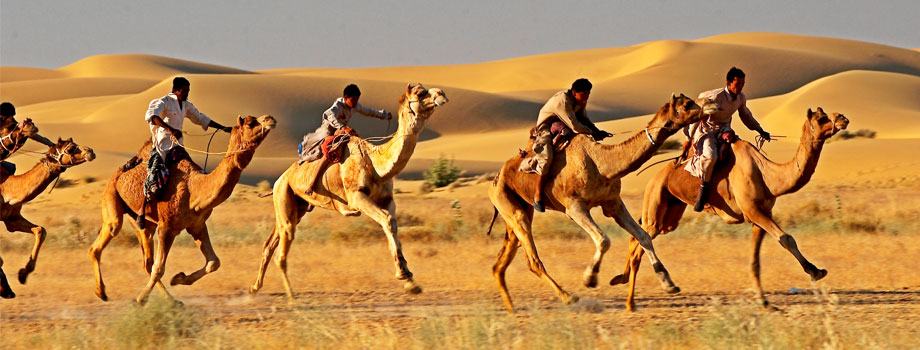-
Wild LIfe in India
India is home to many National parks and Wildlife sancturies within d Read more -
Kerla
With the Arabian Sea in the west, the Western Ghats towering 500-2700 m in Read more -
Taj Mahal
The Taj Mahal is one of the most wonderful tourism destinations in India an Read more -
Varanasi
The land of Varanasi (Kashi) has been the ultimate pilgrimage spot for Hind Read more -
Jaisalmer
The History of Jaisalmer has a charm of its own. Like all other cities of R Read more -
Amber Fort
Established in the year 2005, at JAIPUR (RAJASTHAN, India) we, "SHOW Read more
AGRA
 Agra has a rich historical background, which is amply evident from the numerous historical monuments in and around the city. The earliest reference for Agra comes from the epical age, when Mahabharata refer Agra as Agravana. In the sources prior to this, Agra has been referred as Arya Griha or the abode of the Aryans. The first person who referred Agra by its modern name was Ptolemy.
Agra has a rich historical background, which is amply evident from the numerous historical monuments in and around the city. The earliest reference for Agra comes from the epical age, when Mahabharata refer Agra as Agravana. In the sources prior to this, Agra has been referred as Arya Griha or the abode of the Aryans. The first person who referred Agra by its modern name was Ptolemy.Though the heritage of Agra city is linked with the Mughal dynasty, numerous other rulers also contributed to the rich past of this city. Modern Agra was founded by Sikandar Lodhi (Lodhi dynasty; Delhi Sultanate) in the 16th century. Babar (founder of the Mughal dynasty) also stayed for sometime in Agra and introduced the concept of square Persian-styled gardens here. Emperor Akbar built the Agra fort and Fatehpur Sikri near Agra. Fatehpur Sikri remained his capital for around fifteen years after which the city was left isolated in mysterious circumstances. Jahangir beautified Agra with palaces and gardens despite spending most of his time in Kashmir with which he was passionately attached.
TAJ MAHAL
Completed in 1653 A.D., The Taj Mahal built by the Mughal Emperor Shah Jahan as the final resting place for his favourite Queen, Mumtaz. Finished in by Marvel, it is perhaps India most fascinating and beautiful monument. This perfectly symmetrical monuments took 22 years (1630-1652) of hard labour and 20,000 workers, Masons and Jewellers to built and is set amidst landscaped gardens. Built by the Persian architect, Ustad Isa, The Taj Mahal the bank of the Yamuna river. It can be observed like a Mirage from the Agra Fort from where Emperor Shah Jahan stared at it, for the last eight years his life as a prisoner of his son Aurangzeb.
Open Time : 6 A.M. to 7.30 P.M. (Friday is closed)
AGRA FORT
The great Mughal Emperor Akbar commissioned the construction of the Agra Fort in 1565 A.D., although additions were made till the time of his grandson Shah Jahan. The forbidding exteriors of this fort hight an inner pardise. The fort is crescent shaped, flattended on the east with a long, nearly straight wall facing the river. It has a total perimeter of 2.4 k.m., and is ringed by double castellated ramparts of red sandstone punctuated at regular intervals by bastions. A 9 mt. wide and 10 mt. deep moat surround the outer wall.
Open Time : Sunrise to Sunset.
SIKANDRA
The mausolumn of emperor Akbar represent his philosphy and secular outlook, combining the best of Hindu and Muslim architectures in a superlative region. Completed in 1613 A.D. by his son Jahangir, it is one of the well preserved monuments. This is the last resting place of the Mughal Empror Akbar.
Open Time : Sunrise to Sunset.
ITMAD-UD-DAULAH
Itmad-ud-Daulah is the tomb of Mirza Ghyas Beg, a persian who had obtained service in Akbar Court. The Marvel tomb was made by Emperor Jehangir's Queen, Noorjahan, for his father Mirza Ghyas Beg during 1622-1628 A.D..
The Craftmanship at Itmad-ud-Daulah foreshadows that of the Taj Mahal. It was here that. "Pietra Dura"-the inlay work on marble-so characteristic of the Taj-was first used.
Open Time : Sun rise to Sunset.
FATEHPUR SIKRI
Fatehpur Sikri is an epic in red sandstone. A city of yeasteryear, today lost in the mists of time. Fatehpur Sikri was built by the Mughal Emperor Akbar during 1564 A.D.. Mughal Emperor Akbar had no heir. He visited holy men to enlist their prayers for his son. When he visited Sheikh Salim Chishti who was living at the village of Sikri the saint foretold the emperor that he would be blessed with a son. When is son was born, he is gratitude, constructed his capital city and named it Fatehpur Sikri. Later, due to sortage of water and unrest in North-West, Akbar has to abandon this city.
RADHA SWAMI SAMADHI
This is the head quarter of Radhaswami religion, here the holy ashes of the founder of the faith have been preserved. On the sprawing lawns here, is a beautiful marvel temple with beautiful carving of fruits, flowers, leavesand plants which have been reduced into stone true to nature, and are distinctive speciments of the plastic arts. This is under construction for almost 100 years.
Open Time : 9 A.M. to 5.30 P.M
TAJ MAHOTSAV (SHILPGRAM)
Come February, and it's springtime. The time of the year when nature dawns all its colourful splendour and Agra bursts into colourful celebrations. For 10 days there is sheer celebration of U.P.'s rich heritage of arts, crafts, culture, cuisine, dance and music. Yes, it is Taj Mahotsav time again. There are festivities all around and Agra truly puts on the colours of joy and gets transformed into one non-stop carnival.





